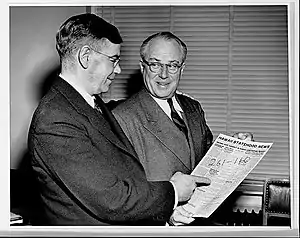Bob Bartlett
Edward Lewis Bartlett (April 20, 1904 – December 11, 1968), known as Bob Bartlett, was an Alaska politician and a member of the Democratic Party.
Bob Bartlett | |
|---|---|
 | |
| United States Senator from Alaska | |
| In office January 3, 1959 – December 11, 1968 | |
| Preceded by | William A. Egan (Shadow Senator) |
| Succeeded by | Ted Stevens |
| Delegate to the U.S. House of Representatives from Alaska's at-large district | |
| In office January 3, 1945 – January 3, 1959 | |
| Preceded by | Anthony Dimond |
| Succeeded by | Ralph Rivers (Representative) |
| Secretary of Alaska Territory | |
| In office January 30, 1939 – February 6, 1944 | |
| Governor | John Weir Troy Ernest Gruening |
| Preceded by | ??? |
| Succeeded by | ??? |
| Personal details | |
| Born | Edward Lewis Bartlett April 20, 1904 Seattle, Washington, U.S. |
| Died | December 11, 1968 (aged 64) Cleveland, Ohio, U.S. |
| Political party | Democratic |
| Spouse(s) | Vide Gaustad |
| Relatives | Burke Riley (son-in-law) |
| Education | University of Washington, Seattle University of Alaska, Fairbanks (BA) |
A key fighter for Alaska statehood, Bartlett served as the Secretary of Alaska Territory from 1939-1945, in Congress from 1945-1959 as a Delegate, and from 1959-his death in 1968 as a U.S. Senator. He was opposed to U.S. involvement in Vietnam, along with his fellow Senator Ernest Gruening, and also worked to warn people about the dangers of radiation. Many acts bare his name, including a major law known as the Bartlett Act, mandating handicap access in all federally-funded buildings.[1]
Bartlett died in office on December 11th, 1968, due to complications from heart surgery. Republican Ted Stevens was appointed by Governor Walter Hickel. Stevens would serve until 2009.
Career

Bartlett was born in Seattle to Edward C. and Ida Florence (née Doverspike) Bartlett.[2] After attending the University of Washington from 1922 to 1924, Bartlett graduated from the University of Alaska in 1925, then began his career in politics. A reporter for the Fairbanks Daily News until 1933, he accepted the position of secretary to Delegate Anthony Dimond of Alaska. Three years later he became the chairman of the Unemployment Compensation Commission of Alaska.
On January 30, 1939, President Franklin D. Roosevelt appointed him secretary of the Alaska Territory, serving under Governor Ernest Gruening. Bartlett served as acting Governor multiple times, such as during the opening of the Alaska-Canada Highway.[3] Beginning in 1945, following the retirement of Anthony Dimond, Bartlett served as the delegate from Alaska to the 79th and the six succeeding Congresses. Continuing his civic service, he was president of the Alaska Tuberculosis Association and served as a member of the Alaska War Council. He labored constantly for statehood, being a member of the Alaska Statehood Committee. Bartlett, as delegate, was the one who introduced the Alaska Statehood Act into Congress, being key in shepherding it's passage. Upon Alaska's admission to the Union in 1959 he became the first senator from Alaska and served until his death in 1968.
Bartlett possessed the reputation of a quiet man of achievement. The Library of Congress estimates that he had more bills passed into law than any other member in congressional history. Before statehood, he was writing legislation (sponsored by other congressional representatives), such as the Alaska Mental Health Enabling Act of 1956. Some of his bills included the Radiation Safety Bill and the Bartlett Act, requiring all federally funded buildings to be accessible to the handicapped.
Career as a U.S. Senator
Bartlett was elected as one of Alaska's inaugural Senators along with former Territorial Governor Ernest Gruening in 1958. Bartlett, on account of his service as a Delegate, was nominated as the senior U.S. Senator, a decision which upset Gruening. Gruening challanged this, leading to a coinflip. Bartlett won the coinflip, which ended the dispute. Due to a rivalry with Gruening, Bartlett nicknamed Gruening 'Junior' for the rest of his life.[4]
Following the 1964 Alaska earthquake, Bartlett was part of the inspection team, and he contributed to efforts to rebuild Anchorage, along with Governor Bill Egan, Representative Ralph Rivers and Senator Gruening.[5]
Personal life
Death
Bartlett was a heavy smoker throughout his life, and his health started to fail in the months leading up to his death, with Bartlett receiving treatment for heart ailments. On December 11th 1968, at the age of 64, Bartlett died following heart surgery at Cleveland Clinic Hospital in Cleveland, Ohio.[5] He was buried in Northern Lights Memorial Park, Fairbanks, Alaska.
Legacy
In 1971, the state of Alaska commissioned Felix de Weldon to create a bronze statue of Bartlett which resides in the National Statuary Hall Collection at the United States Capitol.
A substantial number of buildings, place names and more have been named after Bartlett in Alaska over the years. The most notable of these include Bartlett Regional Hospital (originally St. Ann's Hospital, and known for a time as Bartlett Memorial Hospital), the hospital serving Juneau, Alaska,[6] as well as Bartlett High School in Anchorage and Bartlett Hall at the University of Alaska Fairbanks.
References
- "Bob Bartlett of Alaska". Retrieved 2022-04-29.
- "Bob Bartlett, US Senator - Geni". Retrieved 2022-04-28.
- "Biography: The "Unveiling" of Senator Bartlett". Retrieved 2022-05-03.
- "For Alaska's first senators, an epic battle of ego came down to a coin flip". Juneau Empire. November 1, 2021. Retrieved 2022-04-27.
- "Alaska's first U.S. senator did more for the state than Alaskans remember". Juneau Empire. December 20, 2018. Retrieved 2022-04-27.
- "Accumulated Fragments - Bartlett: the stories behind the name". Juneau Empire. November 14, 2010. Archived from the original on July 10, 2015. Retrieved July 8, 2015.
External links
- United States Congress. "Bob Bartlett (id: B000201)". Biographical Directory of the United States Congress.
- The "Architect of Alaskan Statehood"
- Bartlett Regional Hospital home page



